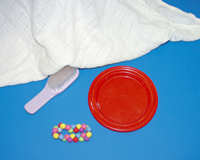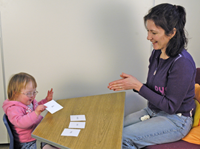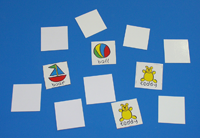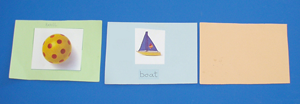Developing working memory skills for children with Down syndrome
To follow
Hughes, J. (2006) Developing working memory skills for children with Down syndrome. Down Syndrome News and Update, 6(2), 57-61. doi:10.3104/practice.348
Working memory is a temporary storage and processing system essential to everyday functioning. It is the system in the brain that supports the daily processing of visual and verbal information as people go about their lives. As well as being essential for language processing, it supports activities that involve holding and manipulating information such as reading and understanding written information, planning and writing a message, or remembering and dialling a phone number.
Working memory is made up of three components (see Figure 1):
- the central executive - the part of the system responsible for processing information
- the phonological loop - responsible for the temporary storage of verbal information.
- the visuo-spatial scratch-pad - responsible for the temporary storage of visual and spatial information.

Figure 1 | The Working Memory Model. After AD Baddeley and GJ Hitch (1974)
Children with Down syndrome have a specific impairment in short-term memory for verbal information (i.e. the phonological loop) and this will make processing verbal information and, therefore, learning from listening, especially difficult for them. Their visual-spatial short-term memory is better than verbal memory, making the ability to learn from visual information a relative strength. This can (and should) be used to support weaker verbal processing abilities.
Intervention strategies that may help to develop the working memory system need to include activities to:
- improve phonological loop function - essential for spoken language learning as it is thought to hold the sound patterns of words. This phonological loop impairment will make processing of single words and speech difficult, and contributes to the speech and language difficulties that many children with Down syndrome face.
- improve remembering of lists of items - children with Down syndrome face short-term memory span difficulties when they are trying to remember two or more items. This may also explain some of the pattern of speech and language delays and difficulties experienced by many children right from infancy.
- improve attention and increase processing capacity - research with typically developing children suggests that increasing attention skills and increasing processing efficiency will aid memory skills as well as increase the storage capacity in the visual-spatial and verbal storage systems.
Intervention strategies
Reducing hearing difficulties
The first issue to address is hearing. If a child's hearing is compromised then he or she is not going to be able to set up clear sound patterns for spoken words. Parents should insist that they are given full details of the hearing assessments carried out for their child, including copies of audiograms and/or tympanograms. They should also be advised on ways of helping their child to improve hearing and listening skills. Reducing background noise will help a child to hear and listen more effectively. Family members and teachers need to be made aware of the need to speak naturally, but clearly, making sure they have the child's attention before beginning to speak. Whenever possible, the child should be able to see their face in order to make use of lip shapes and mouth shapes to help discriminate sounds. Signing is an important aid to understanding new words and to keep your child's comprehension and communication abilities progressing. However, signing will not help your child improve auditory discrimination skills or learn the sound patterns of new words. Therefore, it is important to encourage the ability to discriminate and produce speech sounds and words as well as using signs with children of all ages.
Auditory discrimination of speech sounds
Right from the first year of life, speech sound discrimination is important. Babies will benefit from having the opportunity to listen to a range of speech sounds and sound combinations in play situations. Parents can play babble games to encourage their child to babble. First, it will help to listen and copy back the sounds your baby is making, then to introduce new sounds and see if your baby will listen to and/or copy the new sound.
At about a year old, children with Down syndrome can begin to learn and copy speech sounds as a game, using 'Sound Cards'. Sound cards are cards with a picture representation of each of the sounds of speech, usually with a picture and the letter it represents (e.g. Jolly Phonics cards). Your child will benefit from being shown the card and watching and listening as the sound is made. This will help your child to develop the sound patterns in his/her memory for the sounds of the home language. Once your child is familiar with each of the sounds on its own, he/she can begin to practise hearing the differences between sounds by choosing or pointing to the correct card for a sound that is being made.
As your child progresses through the pre-school years, he/she will continue to benefit from these speech sound listening and discrimination games. At this stage, your child may be saying some of the sounds when shown the cards, and this should be encouraged. Once children are in school, the materials used for phonics can be used to teach them to hear and to say all of the speech sounds needed for spoken language and for reading and spelling. Many children with Down syndrome in primary and secondary schools will not be able to discriminate or say all the speech sounds so parents and teachers may need to look for phonics materials to continue to support progress in this area of development.
Auditory discrimination of words
Word discrimination games can be played as soon as your child has understanding for about 50 - 100 words. Young children can be asked to point to objects that have similar names (e.g. dog/frog, red/bread, chair/bear). Older children can play the same type of game using more advanced vocabulary.



The next step is to develop your child's ability to detect sounds and sound patterns in words - referred to as phonological awareness. Games such as identifying words that rhyme or don't rhyme, or identifying words that start or end with the same sound will help to develop phonological awareness. Pairing speech sounds and letters is included in all phonics schemes when children start at school. This is an important skill and most children enjoy learning this letter-sound correspondence. At the same time, children are beginning to learn a 'sight' vocabulary, a number of words that they can recognise from the pattern of the whole word. This 'sight' vocabulary gives all children an important start in reading and helps to strengthen the letter-sound link, leading to the ability to sound-out unfamiliar words and to think how to spell a word by thinking of how it is pronounced.
Children with Down syndrome should be included in all class reading and spelling activities. This will help to develop their sound discrimination, phonic (sound in print) and phonological awareness (sound in speech) skills.
Activities to improve attention and to increase processing capacity
Activities to improve your child's attention can begin very early and should continue throughout the school years. With very young babies, face-to-face babble games encourage extended periods of attention, as do many of the early games you naturally play with babies. As children move through the pre-school years, attending to teaching games which require sitting still and following instructions are important, first one-to-one with an adult and then as part of a group. In a group, your child has to learn to attend to the 'teacher' and to wait until it is his/her turn. Reading books with an adult is another activity that many children enjoy and will extend the length of time they will sit still and concentrate on a task.
Increasing attention in situations that require your child to process information can begin early with simple choice tasks. The number of items offered for your child to make a choice can start at two and then increase to three or four. You can ask your child to choose one item from a choice of options and then to choose two items from a choice of options. At home, meaningful choices can be encouraged from early on, especially at mealtimes. For example, ask your child, "Would you like a banana or yoghurt?" while holding up each item.
Activities to improve remembering lists or numbers of items
Games to help children to remember two or more items can begin in preschool years and follow on from the simple choice activities as explained above. Hiding games can be introduced, when appropriate, by hiding items under a cloth - first one item, then two and asking your child what is hidden. Remove one object but leave the others and ask your child what is missing.



Picture matching, Hiding game and Finding words
Simple memory games can be extended for older children using objects or picture materials. Line up three pictures face down. Turn over the first and name it - then turn it back to face down. Ask your child to remember what was on the picture. When he/she can do that, turn over two pictures and name each one as you point to it. Turn the pictures back to face down position, point to each one and ask "what is it?". If the child can do this, then repeat the activity with three cards.
Activities designed to teach children to remember items in the order they were given is known as rehearsal training. The game described above is just one example of a rehearsal training strategy. Your child will need lots of practice with this game and it may take a year or two to add an additional item to your child's memory span.
Once your child understands this type of task, you can add variations within the games. Make up some cards with numbers on them. Use the number cards to encourage remembering longer sequences of numbers. You can also use this method to teach counting by putting the numbers in sequence (e.g. 1-5, 5-10, 11-15, etc.). You can also use it to help your child to remember a telephone number.
For children who can read, this game can be used to encourage accurate remembering of short phrases or sentences. This strategy will help with grammar as each of the 'little' words can be incorporated into the phrases and/or sentences (e.g. the, a, an, of, but). These words often get lost in connected speech, but this activity will help your child remember and use these words in phrases and sentences.
Auditory rehearsal
As well as using visual prompts to help your child remember information, it is important to play games that require listening only in order to improve auditory and verbal short-term memory. You need to be aware that listening games, when your child has no picture prompts, will be more difficult for your child. However, you can help your child progress from using visual prompts to hearing and remembering the spoken word. The adult and the child each have a set of three cards with matching pictures on each set. The child must be familiar with the words on the cards. The adult's cards are face down and the adult names each card but the picture cannot be seen. The child then tries to remember which card is where and puts their card with the pictures in the same order as the adult's cards. In this way, the adult says the name of each item, but the child is able to respond using the pictures. Listening games can be played with lists of words or numbers.
Rehearsal strategy
Grouping or organisation skills
Grouping items to be remembered by the categories to which they belong is yet another strategy for increasing the number of items that can be remembered. The aim is to teach your child to organise and store information in memory by categorising - putting items into groups.
Sorting tasks will help your child with grouping and organisational skills. Place one item from each of two categories on the table (for example a cup and a sock), and then hand your child one item at a time from the remaining items (i.e. other eating items and other clothes), and ask him/her to find the category that it belongs to. Alternatively, lay down many items from one category on the table, with one item that does not belong to the same category and ask your child, "Which one does not belong to the group?"


The Pairs game and Grouping by category
Everyday opportunities
It is important that your child is able to incorporate memory skills into everyday daily living. He/she should be encouraged to use the strategies as a way of remembering useful lists or items, for example during a game, running an errand or reporting a message. The aim is for the skill to be generalised from the training situations to everyday life. To achieve this, it is important to practise these skills in other situations. You can help with this by asking your child to deliver messages to others or fetch things from another room. Giving instructions can also help to improve memory skills, as your child will have to remember one, two, three steps of information in order to complete a task. Ask your child to recall the steps of an activity or recall what he/she did at school. After reading a story, ask your child to remember the main events of the story in sequence. Sequential songs such as 'Old MacDonald', 'One, Two, Buckle My Shoe' are very good for teaching sequencing as items in the song are ordered.
Traditional children's games such as 'Pairs' and the ever-increasing shopping list (I went to the shop and bought a….) are good for memory practice. Kim's game, where items are placed and named on the table, then one object is removed - "which item is missing?" is also a good game for memory practice. There is also a wide range of computer programs available for use at home or at school which will support memory and phonics practice.
Supporting working memory in the classroom
In the classroom, children will be given verbal instructions about the day's activities and classroom routines. Much of the instruction during lessons will be given verbally. When children with Down syndrome are in an age-appropriate mainstream classroom, they may find this difficult as it challenges their verbal short-term memory abilities. It is, therefore, important to use as many ways as possible to support learning by using approaches that do not put an excessive demand on verbal short-term memory skills.
Visual support - information that is illustrated visually, with words, sentences, pictures and symbols through lists, timetables and writing frames can support your child's learning in all aspects of lessons. Visual information in the form of pictures, words and sentences can be used to rehearse information from the previous lesson before continuing with a linked lesson, or to revise a whole topic.
Visual records to support verbal presentation - pictures and words will help to focus your child's attention and help him/her to listen, by providing context or background for the teacher's lesson presentation.
Visual records to support learning activities - tasks and activities can be described in structured and clear steps in a list or frame, with line drawings where possible to reinforce meaning. In this way, your child can be supported to complete each activity as necessary, and given explicit encouragement to read and rehearse the list, find out what to do 'next', and follow the list to completion.
Summary
The short-term memory and processing skills described as working memory have been shown to be important for learning to talk, for processing spoken language and for the support of everyday tasks. Aspects of the working memory system seem to be specifically impaired in children and adults with Down syndrome and these impairments could explain some of the difficulties faced by these children and adults. However, improving the functioning of working memory could have a positive impact on the speech, language, and cognitive development of children and adults with Down syndrome.
Recommended reading
Memory development for individuals with Down syndrome (2001). Sue Buckley and Gillian Bird. Down Syndrome Issues and Information, The Down Syndrome Educational Trust. Please visit the downsed online shop at https://store.down-syndrome.org/
Other memory resources
Books and Teaching Materials
*Gathercole, S.E. and Baddeley, A.D. (2001). Working Memory and Language. Psychology Press.
*Green, J. (2003). The Visual Schedule for the Classroom. Greenhouse Publications.
Jolly Phonics from https://www.jollylearning.co.uk/
Software
Mastering Memory. Available in children's (2-11 years) and adult's versions from https://www.masteringmemory.co.uk/
* Available from downsed at https://store.down-syndrome.org/
This article was written for ICAN
and is reproduced with permission to copy



